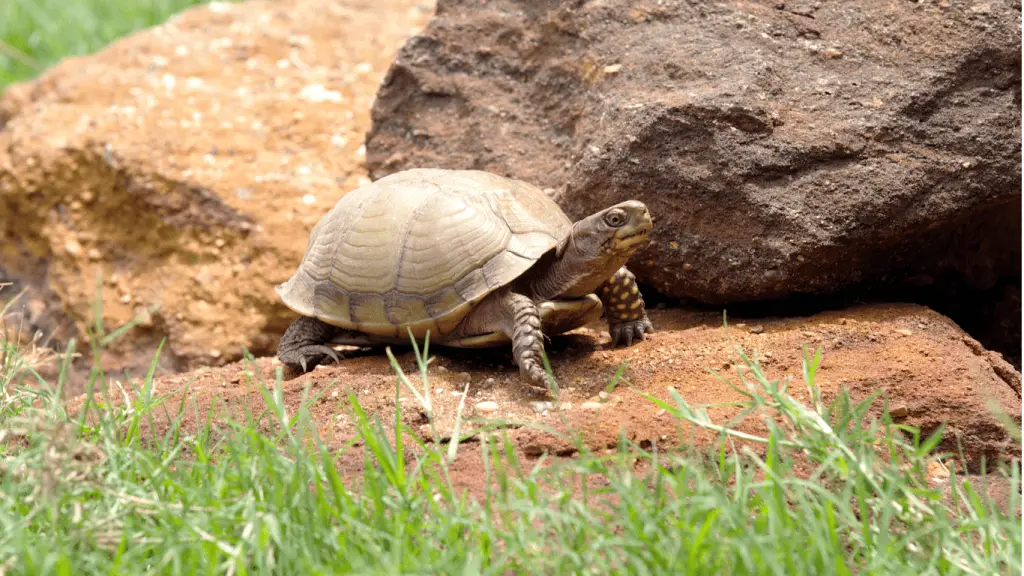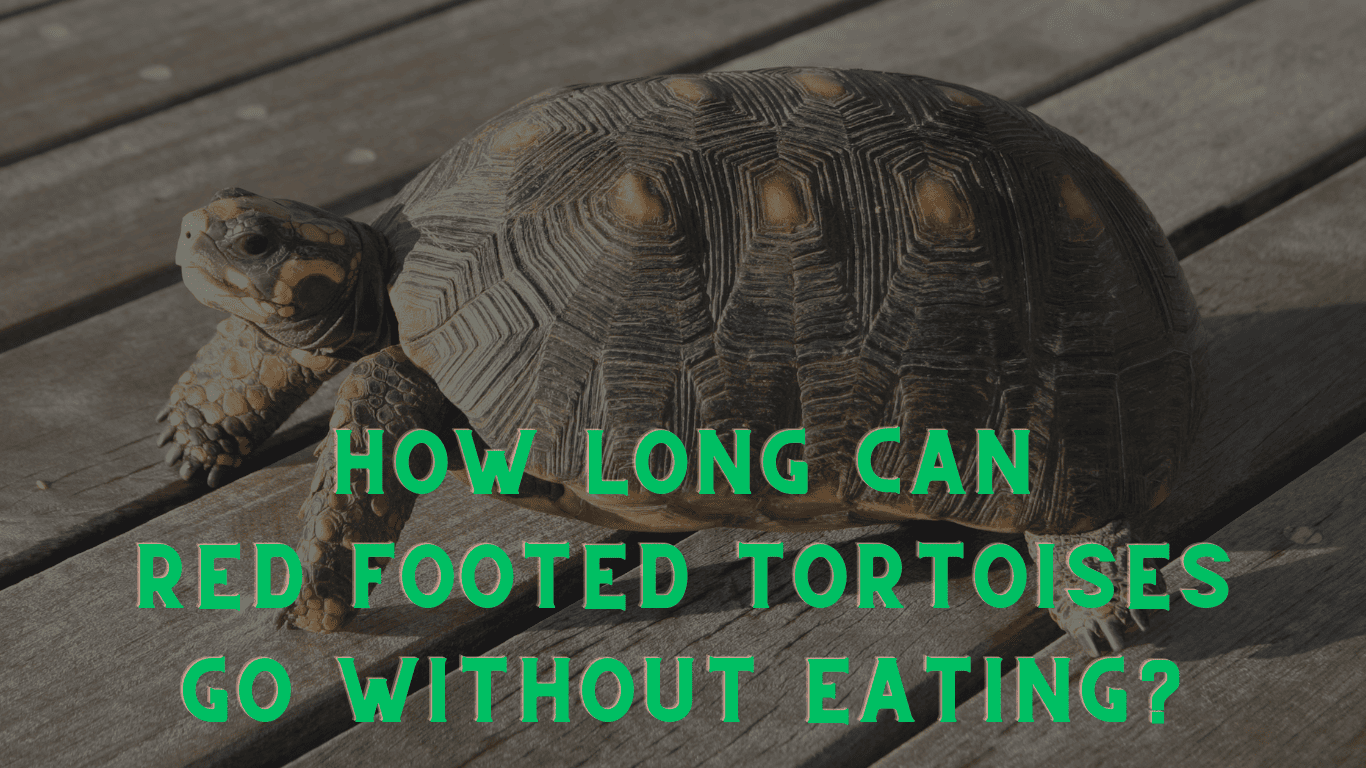The three-toed box turtle is a fascinating species of turtle that is native to the southeastern United States. These turtles are known for their unique hinged plastron, allowing them to seal themselves inside when they feel threatened. They are also known for their distinctive three-toed feet, which give them their name.
If you’re considering getting a three-toed box turtle as a pet, it’s essential to understand the care requirements for these animals. They require a specific diet, habitat, and temperature range to thrive.
This comprehensive guide covers everything you need to know to provide your three-toed box turtle with the best possible care.
Understanding Three-Toed Box Turtles

The three-toed box turtle (Terrapene carolina triunguis) is a subspecies of box turtle found in marshy areas of states like Missouri, Texas, Alabama, and Louisiana. As their name indicates, the three-toed box turtle has three toes on each hind foot. This pet turtle is Missouri’s state reptile.
Physical Characteristics
Three-toed box turtles have a domed shell that grows 5-7 inches (13-18cm). The carapace may be olive or olive brown, with faint yellow or orange lines radiating from the center of each large scute (shell scale). The highest part of its carapace or upper shell is more posteriorly positioned than in other subspecies. The dorsal and limb coloration is commonly wholly absent, although some dark imperfections are typical in adult turtles.
Life Cycle
Three-toed box turtle eggs take around 70 days to hatch. A full-grown three-toed box turtle can be 3 ½ to 6 inches long. They increase in the first six years of life but slow down until they reach their full size at around 12 – 15 years.
Habitat and Diet
Three-toed box turtles are land-dwelling turtles in marshy areas, forests, and grasslands. They are omnivores and feed on insects, worms, snails, slugs, small mammals, and fruits.
Behavior
Three-toed box turtles are generally solitary animals and prefer to live alone. They are active during the day and spend most of their time foraging for food or basking in the sun. During winter, they hibernate and can survive in temperatures as low as 40°F.
Conservation Status
Three-toed box turtles are listed as a species of particular concern in some states due to habitat loss, road mortality, and illegal collection for the pet trade. It is essential to ensure that any three-toed box turtles kept as pets are legally obtained and not taken from the wild.
Physical Characteristics
The three-toed box turtle is a small, land-dwelling turtle with a high-domed shell and typically three toes on each hind limb. Here are some of the physical characteristics of the three-toed box turtle:
Size and Shell
A full-grown three-toed box turtle can be 3 ½ to 6 inches long. They increase in the first six years of life but slow down until they reach their full size at around 12 – 15 years. The carapace, or top shell, is high-domed and maybe olive or olive brown, with faint yellow or orange lines radiating from the center of each large scute (shell scale).
The plastron, or bottom shell, is hinged, allowing the turtle to close up tightly inside its shell for protection. The shell is vital to the turtle’s anatomy, providing protection and support for its internal organs.
Colors and Markings
The three-toed box turtle has a tan or olive carapace, darker seams, and mysterious markings. They also have orange, red, and yellow spots on their head and forelimbs. The defining characteristic of this turtle is its toes. It has three toes on its back feet, which is why it’s known as the Three-Toed Box Turtle.
The claws are sharp and curved, helping the turtle climb and dig. The scales on the legs are thick and durable, providing further protection from predators. Some three-toed box turtles have red eyes, while others have a brownish hue.
Habitat and Distribution
Natural Habitat
The Three-Toed Box Turtle is a subspecies of box turtle native to the south-central part of the United States. They are primarily found in areas with moderate to high rainfall, such as woodlands, grasslands, and marshy areas.
These turtles prefer habitats with dense vegetation and access to water sources such as streams, ponds, and wetlands.
In their natural habitat, three-toed box turtles spend most of their time on land, but they also require access to water for drinking and soaking. They burrow in the soil to escape the heat and regulate their body temperature. They hibernate in shallow burrows or under leaf litter during winter to avoid the cold.
Distribution
The Three-Toed Box Turtle is found in the south-central region of the United States, with the majority of the population residing in Missouri, Alabama, Louisiana, and Texas. They have also been spotted in Oklahoma, Arkansas, and Mississippi.
Their specific habitat requirements limit their distribution, and they are more commonly found in areas with high rainfall and dense vegetation. They are not typically found in urban areas or regions with heavy human activity.
Population
The Three-Toed Box Turtle population has declined recently due to habitat destruction, fragmentation, and other human activities. The International Union for Conservation of Nature (IUCN) has listed them as a species of “Least Concern.”
However, they are still considered a species of particular concern in some states, including Missouri.
Several conservation efforts are underway to protect the Three-Toed Box Turtle and its habitat. These efforts include habitat restoration, captive breeding programs, and public education campaigns to raise awareness about protecting this species.
Behavior and Temperament

Three-toed box turtles are generally shy and solitary creatures that prefer to spend most of their time in their hiding spots. They are not very active during the day and prefer to leave their hiding spots only in the early morning or late afternoon. These turtles are known to be very docile and are generally easy to handle, making them great pets for beginners.
Regarding their behavior, three-toed box turtles adapt and adjust to different environments. They are usually found in marshy areas but can also live in woodlands and meadows. These turtles are known to be excellent climbers and can quickly scale rocky terrain.
Regarding temperament, three-toed box turtles are generally calm and do not display aggressive behavior.
However, they can become stressed if they are handled too much or if they are kept in an environment that is not suitable for them. It is essential to provide them with a comfortable and stress-free environment to ensure that they remain healthy.
During the winter months, three-toed box turtles hibernate in the wild. As pets, they also require a period of hibernation.
It is essential to provide them with a suitable hibernation environment, which should be relaxed, dark, and quiet. They will not eat or drink during this time, so ensuring they are well-fed before hibernation is essential.
Three-toed box turtles are docile, adaptable, and generally easy to handle. They prefer to spend most of their time in hiding spots and are inactive during the day.
They can become stressed if they are handled too much or if they are kept in an unsuitable environment. It is essential to provide them with a comfortable and stress-free environment to ensure that they remain healthy.
Diet and Nutrition
In the Wild
Three-toed box turtles are omnivores, meaning they eat plant and animal matter. In the wild, their diet consists of various foods, including fruits, vegetables, insects, amphibians, frogs, lizards, snakes, and invertebrates. They are opportunistic feeders and will eat whatever is available in their habitat.
In the wild, three-toed box turtles have a diverse diet that changes with the seasons. During the warmer months, they consume more insects and other animal matter. In the cooler months, they eat more plant matter.
In Captivity
When feeding three-toed box turtles in captivity, it’s important to replicate their natural diet as closely as possible. A balanced diet for a captive three-toed box turtle should contain plant and animal matter.
Protein is an essential part of a three-toed box turtle’s diet, and it can be provided through various sources, including insects, meat, and eggs. Insects like crickets, mealworms, and waxworms are a great source of protein for box turtles. Meat, such as cooked chicken or turkey, can also be offered in small amounts.
Vegetables and fruits should also be a part of a three-toed box turtle’s diet. Dark leafy greens like kale, collard, and mustard are excellent choices. Other vegetables like carrots, squash, and sweet potato can also be offered. Fruits like berries, melons, and apples can be given as treats.
It’s important to note that while three-toed box turtles are omnivorous, they do not require much animal matter in their diet. Too much protein can be harmful to their health. A balanced diet with various foods is vital to keeping your three-toed box turtle healthy and happy.
Health and Longevity
Caring for your three-toed box turtle’s health is crucial to ensure a long and happy life. In this section, we will discuss common health issues and their prevention, as well as the life expectancy of these turtles.
Common Health Issues
Three-toed box turtles are generally hardy creatures but can still develop health issues if their care is not optimal. Here are some common health issues that you should watch out for:
- Respiratory infections: These can be caused by poor farming, such as inadequate temperature and humidity levels. Symptoms include wheezing, nasal discharge, and lethargy.
- Parasites: Internal and external parasites like worms and mites can affect three-toed box turtles. Regular fecal exams and parasite prevention treatments are recommended.
- Metabolic bone disease: This is caused by a lack of calcium and vitamin D3 in the turtle’s diet. Symptoms include soft, rubbery shells, swollen limbs, and lethargy.
- Shell rot: This bacterial infection can affect the turtle’s shell. It is caused by poor hygiene and inadequate basking areas. Symptoms include soft, discolored, or pitted areas on the shell.
Preventing these health issues is vital to keeping your three-toed box turtle healthy. Providing proper husbandry, including a balanced diet, adequate temperature and humidity levels, and a clean enclosure, can go a long way in preventing these issues.
Life Expectancy
Three-toed box turtles are known for their long lifespans, with some individuals living up to 100 years in the wild. They can live up to 30-40 years in captivity if provided with proper care. However, their lifespan can be significantly shortened if they are not given the necessary care.
To ensure a long and healthy life for your three-toed box turtle, provide a balanced diet that includes calcium and vitamin D3 supplements, a clean and spacious enclosure, and regular visits to a veterinarian specializing in reptile care. By providing optimal care, you can enjoy the company of your three-toed box turtle for many years.
Keeping Three-Toed Box Turtles as Pets
If you are looking for a low-maintenance pet with a long lifespan, the three-toed box turtle might be the perfect choice for you. These tiny turtles are native to the south-central part of the United States and can live up to 100 years in the wild and up to 40 years if bred in captivity and receiving proper care. This section will discuss how to keep three-toed box turtles as pets.
Housing
Three-toed box turtles should be kept in an enclosure providing enough space to move around. A 30-gallon tank is suitable for one adult turtle. The enclosure should have a hiding spot and enough floor space for the turtle to bask and move around.
You can use coconut husk fiber, bark chips, clean sand, cypress mulch, or topsoil as substrate. Leaf litter can also be added to the enclosure to provide hiding spots and to create a natural environment.
If you live in an area with a warm climate, you can create an outdoor enclosure for your turtle. The outdoor enclosure should be secure and provide enough space for the turtle to move around. The enclosure should have a sunny and shady area so the turtle can regulate its body temperature.
Temperature and Humidity
Three-toed box turtles need a warm and humid environment to thrive. The enclosure should have a ceramic heater to provide heat and a hygrometer to monitor the humidity. The temperature should be kept between 75-85°F during the day and not drop below 70°F at night. The humidity should be kept between 60-80%.
Feeding
Three-toed box turtles are omnivores and should be fed a balanced diet. The diet should consist of vegetables, fruits, and insects. You can feed your turtle collard greens, kale, carrots, sweet potatoes, squash, strawberries, and melons. You can also feed your turtle mealworms, crickets, and earthworms.
It is essential to provide your turtle with a source of vitamin D3. You can do this by placing a UVB light in the enclosure. The light should be on for 10-12 hours per day.
It is also essential to provide your turtle with clean water. You can use a shallow water dish or a small aquarium with a filter. The water should be changed regularly to prevent bacterial growth.
Breeding and Reproduction
Breeding and reproduction are essential to the Three-Toed Box Turtle’s life cycle. As with most turtle species, ensuring the optimal health and size of the breeding pair before initiating the breeding process is essential.
Sexual Maturity
The Three-Toed Box Turtle reaches sexual maturity between 7 and 10, with females generally more prominent than males. Size is crucial in determining sexual maturity, and the female should be of optimal health to ensure successful reproduction.
Mating
Mating usually occurs during the spring and summer months. The male approaches the female and begins to court her by bobbing his head and walking around her. If the female is receptive, she will allow the male to mount her. Copulation can last from a few minutes to several hours.
Egg Laying
After successful mating, the female will begin to prepare for egg-laying. She will start to dig a hole in the ground in a secluded area, usually in a sunny spot. The hole should be deep enough to accommodate the eggs, ranging from 1-7 in number.
Incubation
The eggs will take around 70 days to hatch and require specific environmental conditions to thrive. The temperature should be maintained between 84 and 88 degrees Fahrenheit. If the temperature falls below this range, the eggs may not hatch, or the hatchlings may be deformed.
Hatchlings
Once the eggs hatch, the hatchlings will emerge from the ground and begin their journey into the world. They are tiny and vulnerable, and it is essential to protect them from predators. They will require a suitable habitat with food, water, and shelter to thrive.
Breeding and reproduction are crucial aspects of the Three-Toed Box Turtle’s life cycle. It is essential to ensure the optimal health and size of the breeding pair, provide suitable environmental conditions for egg incubation, and protect the hatchlings to ensure the species’ continued survival.
Three-Toed Box Turtle Conservation
The three-toed box turtle is a small terrestrial turtle native to the United States. This species is currently listed as a species of most minor concern by the International Union for Conservation of Nature (IUCN). However, there are still concerns about their population numbers and conservation status.
Population
The population of three-toed box turtles has decreased in some areas due to habitat loss and fragmentation. These turtles require specific habitats, such as forests, grasslands, and wetlands, to thrive. Unfortunately, human activities such as agriculture, urbanization, and logging often destroy or alter these habitats. The decline in population numbers has led to some states listing the species as protected or endangered.
Conservation
Conservation efforts for the three-toed box turtle focus on habitat conservation and restoration. Protecting and restoring their habitats is crucial to maintaining healthy populations of this species. Conservation organizations work with landowners, government agencies, and other stakeholders to preserve and restore habitats for these turtles. In addition, captive breeding programs are also used to help increase population numbers and genetic diversity.
Predators
Three-toed box turtles have several natural predators, including raccoons, skunks, opossums, and snakes. These predators can have a significant impact on the population of this species.
Therefore, monitoring predator populations and implementing measures to reduce their impact on turtles is essential. This can include using predator-proof fencing around habitats, relocating predators, and removing invasive species that may attract predators.
In conclusion, conserving the three-toed box turtle is crucial to maintaining healthy populations of this species. Protecting and restoring their habitats, implementing captive breeding programs, and monitoring predator populations are all important steps in ensuring the survival of this species.
Frequently Asked Questions
What do Three-Toed Box Turtles need?
Three-Toed Box Turtles require a habitat that mimics their natural environment. They need a warm and humid environment and a basking area to warm themselves under a heat lamp. They also require a source of UVB lighting to help them synthesize vitamin D3, which is essential for their health. Additionally, they need a substrate that is easy to clean and maintain, such as coconut coir or cypress mulch.
How often should I feed my three-toed box turtle?
Three-Toed Box Turtles are omnivores and require a balanced diet that includes animal and plant matter. Generally, they should be fed every other day, with a diet of 50% protein (such as insects, worms, and snails) and 50% fruits and vegetables. Providing various foods to ensure they receive all the necessary nutrients is essential.
How much space does a three-toed box turtle need?
Three-Toed Box Turtles require a minimum enclosure size of 4 feet by 2 feet, with a height of at least 12 inches. The enclosure should be large enough to provide them with plenty of room to move around and a basking area and hiding spots. It’s important to note that they are not good climbers, so the enclosure should have low walls or be covered to prevent escape.
Can you keep a three-toed box turtle as a pet?
Yes, Three-Toed Box Turtles can make great pets for those willing to provide them with the proper care and environment. However, it’s important to note that they can live up to 30-40 years in captivity, requiring a long-term commitment. Additionally, they are not as social as other types of pets, so they may not be the best choice for those looking for a highly interactive pet.
Do three-toed box turtles bite?
Yes, Three-Toed Box Turtles can bite if they feel threatened or stressed. However, they are generally docile and will not bite unless provoked. Handling them gently and with care is essential to avoid causing them stress or fear.
What is the lifespan of a Three-Toed Box Turtle?
Three-Toed Box Turtles can live up to 30-40 years in captivity if provided with the proper care and environment. In the wild, their lifespan is shorter due to predators and other environmental factors.
It’s important to note that they are a long-term commitment and require significant care and attention over their lifespan.0-40 years in captivity if provided with the proper care and environment. In the wild, their lifespan is shorter due to predators and other environmental factors.
It’s important to note that they are a long-term commitment and require significant care and attention over their lifespan.




Leave a Reply